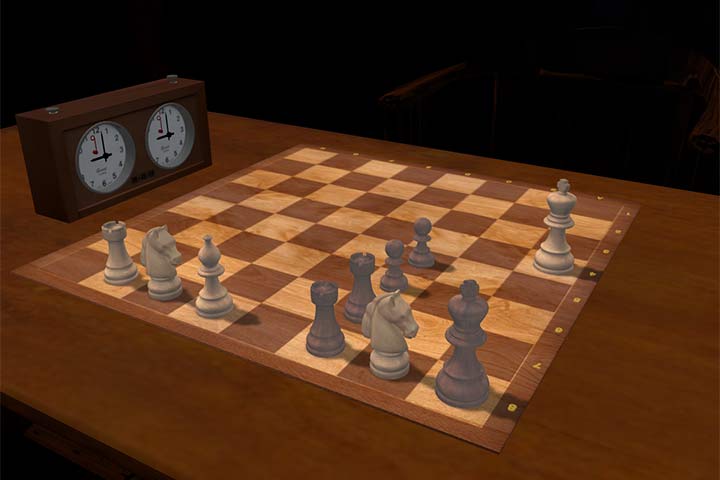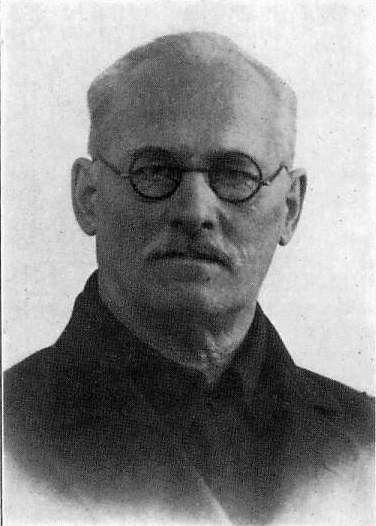


When Isaac Newton wrote his famous quote, those giants of chess were almost a thousand years old, but most of their modern dwarves had yet to come. In medieval Arabia, under the early chess players of the “shatranj” rules where for example the queen as fers would only move one square diagonally, the first chess compositions came up. They were not merely used for leisure and amusement, but to tell tales. It is most likely those tales were invented, such as the famous one of Dilaram who is saved by a checkmate combination. Frederic Friedel wrote a short article on the puzzle for interested readers a few years ago.
Half a millennium after its invention, chess had become more than just a game, it had become a literary vessel. It had become art.
Luca di leida, partita a scacchi, circa 1518 | Source: Lucas van Leyden CC BY 3.0, via Wikimedia Commons
(Click or tap to enlarge)
Retelling the story on how modern chess came into existence is not my intention. Damiano, Lucena, del Rio and many others wrote their works. A priest named Ruy Lopez would immortalize his name by inventing the “Spanish opening”, as it is called in German — the one named after him in English.
In the 18th century a man from a country now only known as a zone of a bloody and inhumane war of fanatics against fanatics against civilians wrote books with modern mansuba: Philip Stamma from Aleppo, Syria. Stamma was part of a movement that soon would dominate chess: Gatherings in coffee houses. Stamma, of French nationality, was a regular at Slaughter’s Coffee House in London. A great musical talent defeated him in 1747 in a chess match: F.A.D. Philidor. Stamma incorporated the old and new, having played under Arabic rules and under western rules, having created mansuba, the Arabic riddles, under the new rules. For chess composition, the frugal grounds were laid but there were no rules yet on what would define beauty. This would change in the 19th century with the rise of Johann Berger, and the term “chess study” was cemented by Josef Kling and Bernhard Horwitz in their 1851 book Chess studies; or, Endings of Games.
 Endgames and chess composition were now tied together into a term called "chess study". They were something to carefully learn and teach, having to be studied to be understood, according to their name. And yet the term began to name a kind of art rather than the deep theoretical endgames, coexisting with one another in Chéron’s mastepiece "Lehr- und Handbuch der Endspiele" a century later.
Endgames and chess composition were now tied together into a term called "chess study". They were something to carefully learn and teach, having to be studied to be understood, according to their name. And yet the term began to name a kind of art rather than the deep theoretical endgames, coexisting with one another in Chéron’s mastepiece "Lehr- und Handbuch der Endspiele" a century later.
But let’s not jump ahead too much. In 1895 it was again a Spanish priest, this time in Ireland, who would immortalize him into chess in a many-times-told story called the "Saavedra study". 97 years later, an aspiring young child would see this study in a book by Laszló Orbán, and your author was hooked onto chess studies...
 The Expo 1900 promised a century that would remain in the memory of humanity for its great technological advantages. Who knew, maybe within a century a man would set his foot on the Moon, maybe we would be able to all have a telegraph at home, able to send messages in only a few minutes to everyone else on the planet? Possibly cars would fly? Or maybe one Jules Verne would be right, in his lost story "Paris in the 20th century", only discovered at the end of said century, that people would even be able to communicate instantly all around the world with electronic letters. In any case the century was to become prosperous for humanity, the best of all.
The Expo 1900 promised a century that would remain in the memory of humanity for its great technological advantages. Who knew, maybe within a century a man would set his foot on the Moon, maybe we would be able to all have a telegraph at home, able to send messages in only a few minutes to everyone else on the planet? Possibly cars would fly? Or maybe one Jules Verne would be right, in his lost story "Paris in the 20th century", only discovered at the end of said century, that people would even be able to communicate instantly all around the world with electronic letters. In any case the century was to become prosperous for humanity, the best of all.
14 years later, the dream was shattered. The devil has shown his bloody face of war, and even the last resistance — the Christmas Truce of 1914, the most humane gesture in an inhumane time, showing that above all the kings of the world there was one who still united the people — was not enough to end the slaughter. Throughout the century humanity would see the worst it had to offer.
Only at the end of the century the same feeling of endless possibilities came up again, the world had finally put most of its differences aside, the Cold War was over and the threat of Nuclear Holocaust finally had ceased. The new millennium was ahead, we would no longer be Earthlings but children of the stars, of the universe which lied ahead to be colonized. All of humanity would work together on a bigger thing, never before was technology and medicine so advanced, if we survived now we would survive forever...
As Charles Beaumont wrote, you can’t contain the devil for long. Less than one year into the new millennium, the world was at war again. And the outcome yet is unclear. What will be in 2100? Are we doomed to repeat our mistakes in every century?

Let us return to 1895. The “father” of the modern chess study started composing. Born on March 14th, 1866, the first study of Alexey Troitzky (right) was printed in 1893, but his first period of work from 1895 to 1901 showed mainly classical themes, such as domination, positional draw and some problem themes. Then however he worked on the — now classical — foundation of modern chess studies, seeing them as part of the entire game and not only the endgame, trying to give lively piece play, rich thematic content with underpromotion, systematic movement, the battle of different pieces or groups of pieces against each other.
This second period is estimated to have been from 1905 to 1917. In 1908 and 1917 he lost all of his material at fires, being a forest worker. His book 500 Endspielstudien was published in 1924, having numerous studies (incorrectly) reconstructed from memory. Starting that year his third period started, lasting until his death. He would show the themes from before but with rich play, silent and hidden threats, gamelike play. In 1928 he was honored as Deserved Artist of the USSR, and in 1934 as Master of Sports. Sadly the ugly face of war showed up soon enough, a failed painter from Braunau am Inn had taken over the German government, intent on destroying as many people as he can, lying about the German "master race", one he would in his final days try to destroy as well, showing that all along he was a liar.
In 1942 the Fuehrer’s final days were long away, but Troitzky’s final days came during a hunger genocide against over a million people carried out by the Wehrmacht from 1941 to 1944 known as the Siege of Leningrad. The Russian city was surrounded by Wehrmacht troops, making it unable to supply food to the city. The residents, desperate as the food in the city was all used up, turned to cannibalism, eating rats, eating dirt, all out of hunger and most likely still being disgusted at each, and eventually dying from starvation. One of the victims who died during that time was Troitzky, on August 14th, 1942. As if to top it off, adding more insult to the great injury, his notes once again were lost...
Certainly there is something to this man, who on his 1930 photo looks like a man of great authority, a professor possibly. And indeed, his authority lied in chess composition, in his work, of which over 750 studies remained.
Today we can only look at a selection of this vast wonderland. He also created a few dozen other chess problems such as retractors. More of his studies can easily be found for free on the internet where also hopefully some of his books — in the public domain in most countries since January 1st, 2013 — can be found.
Click or tap a game in the list to switch games
Troitzky’s work on the endgame of two knights against one pawn led to the discovery of the "Troitzky line", the line that shows where a single pawn will always lose when blocked by a knight. The trick in the endgame is to use the pawn’s extra tempi in a stalemate position to deliver the checkmate, as can be seen in the analytical position included below. In one tourney, a famous grandmaster was left with only two knights against a bare king, telling his opponent that recently a discovery was made on how to win this endgame. Of course, that was just a joke made for his shocked opponent, but with an extra pawn on the opposing side the endgame is indeed won in many cases, often even outside the Troitzky line, although not in all cases. Troitzky’s research — the line goes a4-b6-c5-d4 for black pawns, as well as mirrored — led to other studies being created based on that knowledge. We will close with a study by Abram Gurvich, showing a beautiful knight checkmate where the knowledge is applied in a sideline.
On another funny note, I was once witness to a bad slip of the tongue by a composer referring to Troitzky as "Trotzky". Of course our hero was unrelated to the political activist.
Speaking of politics: Next time we will talk about someone who supposedly was congratulated by Lenin himself in a letter — the Platov brothers.
(Note that all dates given here are in the Gregorian calendar, as used in most parts of the world today. The official calendar dates of the Julian calendar used in Russia at the time will be different, as it was thirteen days behind the Gregorian calendar.)
You probably know that you can move pieces on our replay boards to analyse, and even start an engine to help you. You can maximize the replayer, auto-play, flip the board and even change the piece style in the bar below the board.
At the bottom of the notation window on the right there are buttons for editing (delete, promote, cut lines, unannotate, undo, redo) save, play out the position against Fritz and even embed the ChessBase game viewer on your web site or blog. Hovering the mouse over any button will show you its function.

World Federation for Chess Composition (www.wfcc.ch)
| Advertising |